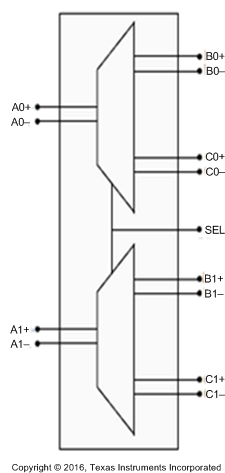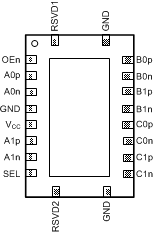SLASE74F May 2015 – September 2016 HD3SS3212
PRODUCTION DATA.
- 1 Features
- 2 Applications
- 3 Description
- 4 Revision History
- 5 Device Comparison Table
- 6 Pin Configuration and Functions
- 7 Specifications
- 8 Parameter Measurement Information
- 9 Detailed Description
- 10Application and Implementation
- 11Power Supply Recommendations
- 12Layout
- 13Device and Documentation Support
- 14Mechanical, Packaging, and Orderable Information
Package Options
Refer to the PDF data sheet for device specific package drawings
Mechanical Data (Package|Pins)
- RKS|20
Thermal pad, mechanical data (Package|Pins)
Orderable Information
1 Features
- Provides MUX/DEMUX Solution for USB Type-C™ Ecosystem for USB 3.1 Gen 1 and Gen 2 Data Rates
- Compatible With MIPI DSI/CSI, FPDLinkIII, LVDS, and PCIE Gen II, III
- Operates up to 10 Gbps
- Wide –3-dB Differential BW of over 8 GHz
- Excellent Dynamic Characteristics (at 5 GHz)
- Crosstalk = –32 dB
- Off Isolation = –19 dB
- Insertion Loss = –1.6 dB
- Return Loss = –12 dB
- Bidirectional "Mux/De-Mux" Differential Switch
- Supports Common Mode Voltage 0 to 2 V
- Single Supply Voltage VCC of 3.3 V
- Commercial Temperature Range of 0°C to 70°C (HD3SS3212RKS)
- Industrial Temperature Range of –40°C to 85°C (HD3SS3212IRKS)
2 Applications
- USB Type-C™ Ecosystem
- Desktop and Notebook PCs
- Server/Storage Area Networks
- PCI Express Backplanes
- Shared I/O Ports
- FPDLinkII and FPDLinkIII Switching
3 Description
The HD3SS3212 is a high-speed bidirectional passive switch in mux or demux configurations suited for USB Type-C™ application supporting USB 3.1 Gen 1 and Gen 2 data rates. Based on control pin SEL, the device provides switching on differential channels between Port B or Port C to Port A.
The HD3SS3212 is a generic analog differential passive switch that can work for any high-speed interface applications requiring a common mode voltage range of 0 to 2 V and differential signaling with differential amplitude up to 1800 mVpp. It employs adaptive tracking that ensures the channel remains unchanged for the entire common mode voltage range.
Excellent dynamic characteristics of the device allow high-speed switching with minimum attenuation to the signal eye diagram with very little added jitter. It consumes <2 mW of power when operational and has a shutdown mode exercisable by OEn pin resulting <20 µW.
Device Information(1)
| PART NUMBER | PACKAGE | BODY SIZE (NOM) |
|---|---|---|
| HD3SS3212 | VQFN (20) | 2.50 mm × 4.50 mm × 0.5-mm pitch |
| HD3SS3212I |
- For all available packages, see the orderable addendum at the end of the data sheet.

